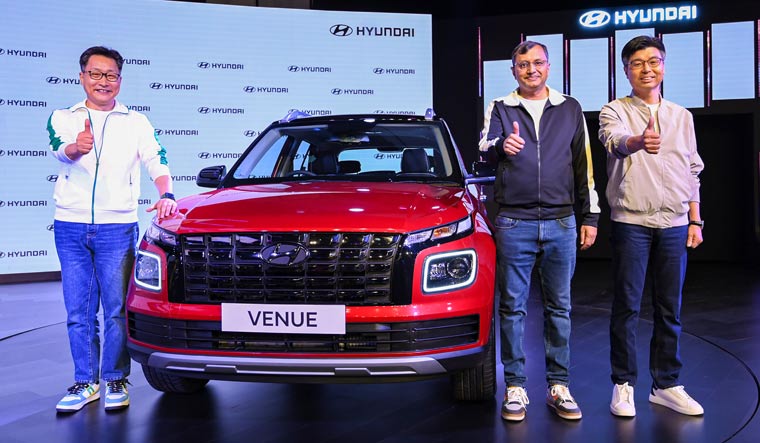In an auto industry dominated by the (then) quasi-government-backed Maruti Suzuki, Korean automaker Hyundai came out of nowhere in the mid-1990s and made inroads with its nifty mix of celebrity endorsements (remember Shah Rukh making Santro look cool?) and an aggressive marketing strategy, tapping into changing car buying preferences.
A quarter century down the line, the company seems to have fine-tuned the art of being first with new products, variants and features. Even if some of these products (like 2019’s electric SUV Kona priced at above Rs 26 lakh which nobody really bought) flop, the strategy is to build the brand reputation as cutting edge, and continue experimenting.
This strategy has stood the company, which recently shifted to its glitzy new corporate headquarters in Gurgaon, in good stead. In recent years, it was the first to move away from small cars and concentrate on sports utility vehicles (SUVs) with Tucson and Creta, even before the trend hit mainstream. Now, with the rest of the competition playing catch-up in the SUV space, Hyundai is all set on expanding the category — it just released on Thursday its entry-level SUV Venue at prices starting Rs 7.53 lakh. The company wants to seal the category in the face of rising competition in the space (market leader Maruti Suzuki is slated to make a big play into the segment before Diwali) by launching the facelift of its premium SUV Tucson pretty soon to cover all flanks, considering it already dominates the mid-level SUV space with Creta.
Hyundai India CEO Unsoo Kim and marketing head Tarun Garg spoke to THE WEEK after the launch of the new model. Excerpts from the round-table interaction:
Championing the SUV segment’s rise
We were the first one to spot that trend and introduce the right product. When Hyundai launched Venue in 2019, compact SUV was a very basic segment. Today, we have so many firsts in the SUV category, raising the benchmark.
Customer does not think (on the lines of) this model’s market share is this much, so let me buy this. (When) a customer is excited by a (particular) launch, they then buy that product. Which (is what) happened (in the shift from) hatchbacks (small cars) to SUVs.
Is age of sedans and hatchbacks (small cars) over?
Even the reduced volumes of sedans are still substantial. We have had launches and product upgrades in the last two years like Nios, Aura, Verna etc. In my experience, I have not seen a sedan do so well after changes (like the Verna relaunch).
SUVs may be popular, but there is a strong market, whether it is sedans or hatchbacks. Obviously, as the trend shifts, the number of launches gets adjusted.
Supply chain issues
Supplies depend on so many factors, not demand. Today we are sitting on a backlog of 1.35 lakh customers, which we are trying to fulfil as fast as possible.
We are trying our best. We are hoping things will improve. There are so many factors.
Tata overtaking Hyundai as the No.2 automaker in the country
Hyundai has been a very strong player in the Indian market for the past 26 years. And, we have every reason to believe we will continue to do so. I cannot comment on market share because that will depend on others also. But I can tell you that in terms of launches, technology, products, volumes and sustainability, we are very confident of our strategy.
Healthy competition means good choices for the customer, good for the economy, good for jobs. We should all be happy that the Indian auto industry is contributing to the economy. We should be happy that more and more companies are doing well.
Electric vehicles strategy
We have earmarked Rs 4,000 crore for electric vehicles; we will be launching six electric car models by 2028. We have already announced that we will be launching soon in India the IONIQ 5, which won the ‘World Electric Car of the Year’ this year.
We are going top down, that is a strategy that helps us to test a lot of things. Plus it helps in building the brand. And until the battery prices come down, it is a very good way of making the ecosystem ready. We have announced that in the six electric vehicles (to be launched within 2028) we will have SUVs, sedans and all categories.
How has customer profile and tastes have changed?
Customer aspirations are driving a lot of things. One is Gen Z. Customers are getting younger. Forty per cent of customers are below the age of 35. And very clearly, they are going for feature-rich models — connectivity, sunroof etc.
Something we find unbelievable is that in 2018 while only 16 per cent of cars sold in India were above Rs10 lakh, now it has become 37 per cent. In three years, 16 per cent has become 37 per cent (And for Hyundai, 20 per cent became 40 per cent)
It means that customers are no longer looking for cars as means of going from point A to point B. They want features, technology, they want convenience, they want design, they want space, they want their family to travel in great comfort. This is a very key trend that has emerged, and that is why we have seen this trend moving from hatches to SUVs.
For three years, we have been watching this trend, but it has happened. Now, SUVs are 40 per cent against 34 per cent for hatches. This is something very important. (It shows) Indians are ready for global technologies and features, and it is our duty to give it to them.





